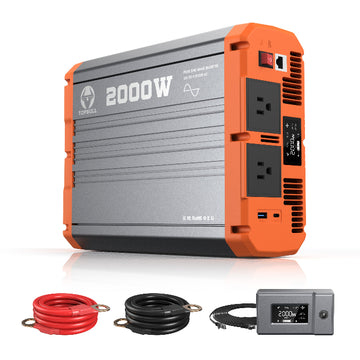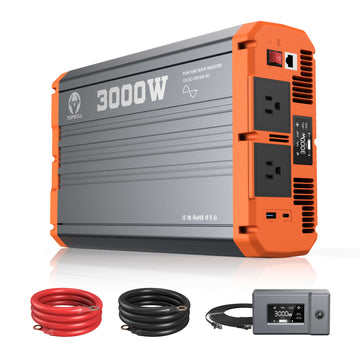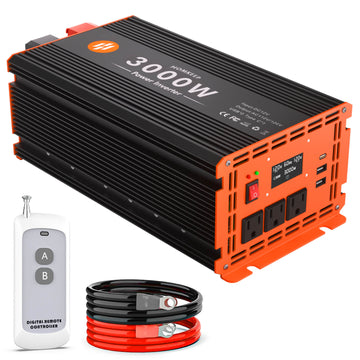In today's unpredictable world, having a reliable power backup system for your home during emergencies is crucial. Whether you're facing a power outage due to a storm, a natural disaster, or other unforeseen events, an inverter can provide a dependable solution.
This guide will walk you through using an inverter for emergency home backup power, helping you keep essential appliances running and stay prepared for any power disruption that may arise. By understanding the right inverter for your needs, you can ensure your home remains powered during critical times.
Related Reading:
What Size Power Inverter Is Needed for a House [Full Guide]
12 Volt DC Power Inverter: In-Depth Learning and Buying Guide
How Does a Power Inverter Work for Home Backup
Before exploring how to choose and use an inverter, it's important to understand its role in providing home backup power during emergencies.
A power inverter's main function is to convert DC (Direct Current) power, typically stored in batteries or generated by solar panels, into AC (Alternating Current) power, which is used by most household appliances. In the event of a power outage, the inverter can quickly convert the stored DC energy into AC power, allowing you to run essential devices such as lights, refrigerators, and medical equipment.
By understanding how this conversion works, you can effectively harness your inverter's capabilities to keep your home powered until the main power grid is restored. Knowing the inverter's operation is key to optimizing its use and ensuring you have reliable backup power when you need it most.
How Solar Power Inverters Enhance Emergency Home Backup Systems
While traditional inverters can provide essential power during an emergency, integrating solar power into your backup system offers significant additional benefits.
When paired with a battery storage system, solar power inverters create a reliable off-grid solution, ensuring long-term backup power. This integration is particularly valuable in regions prone to frequent power outages, as it allows you to store energy on sunny days and use it during emergencies, minimizing reliance on the grid.
Investing in a solar power inverter not only secures your backup power needs but also helps reduce overall energy consumption, making the system more sustainable and eco-friendly. By combining solar energy with your inverter, you can achieve greater energy independence while ensuring reliable power during critical times.
How to Choose the Best Power Inverter for Emergency Home Backup
When selecting a power inverter for emergency use, it's essential to carefully consider several factors to ensure the system meets your home's specific needs. Let's explore the key points to help you make the best choice for your backup power solution.
First, assess your power requirements. The inverter's size should be based on the total wattage of the appliances you intend to power during an emergency. Ensure that the inverter can handle the load of essential devices like lights, refrigerators, and medical equipment.
Additionally, consider the battery compatibility and inverter efficiency, as these factors significantly impact the overall performance and longevity of your backup system.
Best Option: Topbull's Pure Sine Power Inverters
Based on the factors above, here we recommend three excellent options from Topbull, designed to meet various household backup power needs:
-
2000W Pure Sine Wave Inverter: Ideal for small households or light power usage. This inverter is perfect for essential devices like lights, fans, and small appliances.
-
3000W Pure Sine Wave Inverter: Suitable for medium-sized homes, this inverter can handle more demanding appliances like refrigerators, TVs, and some power tools.
- 4000W Pure Sine Wave Inverter: Designed for larger homes or those with higher power consumption, this inverter can support multiple appliances simultaneously, ensuring that your essential needs are met during a power outage.

How to Use an Inverter for Emergency Home Backup Power
Now that you understand how inverters work and how to select the right one, let's go over the essential steps for setting up your inverter for emergency backup power at home.
Start by connecting your inverter to a reliable battery bank, which will store the energy for the inverter to convert into usable AC power. Once your inverter is securely connected to the battery, you can begin plugging in your essential appliances. Prioritize high-priority devices like lights, fans, a refrigerator, or medical equipment to keep your home operational during an outage.
It's crucial to manage your energy usage to avoid overloading the inverter. Running too many devices simultaneously can cause inefficiencies or even damage the system. If you have a solar power system integrated with your inverter, ensure it is set up correctly so that you can store energy during sunny days and utilize it when needed.
By carefully connecting and prioritizing your devices, you'll maximize your inverter's effectiveness and ensure reliable power during emergencies.
Common Mistakes to Avoid in the Use of a Solar Inverter for a House
While using an inverter for emergency power is relatively simple, several common mistakes can undermine its effectiveness or cause long-term damage to the system. Avoiding these errors will ensure your inverter works efficiently and safely when you need it most.
-
Undersizing the Inverter: One of the most frequent mistakes is choosing an inverter that's too small for your household's power needs. To avoid this, always calculate the total wattage of the appliances you plan to run during an outage. Select an inverter that can comfortably handle this load to prevent overloading and ensure reliable power.
-
Poor Battery Maintenance: If you're using a battery to store power for your inverter, proper maintenance is essential for long-term reliability. A poorly maintained battery will lose its charge more quickly, leaving you without power during an emergency. Regular checks, proper charging, and cleaning are necessary to keep the battery in optimal condition.
- Improper Wiring: Incorrect wiring or unsecured connections can lead to power loss, inefficiency, and potential safety hazards. Always use the correct cables and follow the manufacturer's guidelines to ensure that everything is set up properly. This will reduce the risk of damage and ensure the safe operation of your inverter system.
By being aware of these common mistakes and taking preventive measures, you can ensure that your solar inverter system operates smoothly, providing the reliable backup power you need during an emergency.
FAQs About Using Emergency Household Power Inverters
Can I use an inverter to power my entire house during an emergency?
It depends on the size of the inverter and the total energy consumption of your home. A larger inverter can support more appliances, but you may need to prioritize essential devices such as lights, the refrigerator, or medical equipment to avoid overloading the system.
What is the best type of inverter for home backup power?
A pure sine wave inverter is generally the best choice for home backup power, as it provides clean, stable AC power that is safe for all appliances, especially sensitive electronics like computers, televisions, and medical devices.
How long can an inverter power my home during an outage?
The duration of backup power depends on the capacity of the inverter and the connected battery. Larger batteries can provide power for a longer period, but managing your energy consumption by only powering essential devices can help extend the backup time, ensuring you can stay powered for a longer period during an outage.
Final Words
Using an inverter as an emergency backup power source for your home is a reliable and effective way to keep your household running during power outages. By understanding how inverters work, selecting the right model, and properly maintaining your system, you can ensure that you're always prepared for unexpected interruptions.
For optimal performance, consider Topbull's reliable inverters. They help you manage varying power needs and provide steady backup power when you need it most. With the right setup, you can enjoy peace of mind without worrying about power loss.












